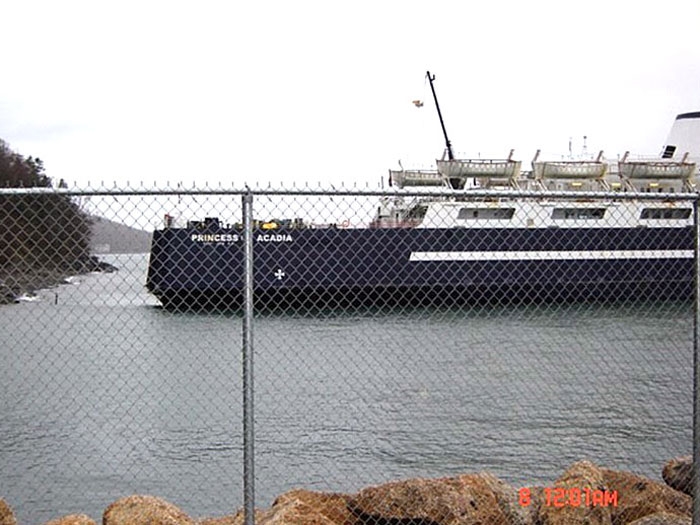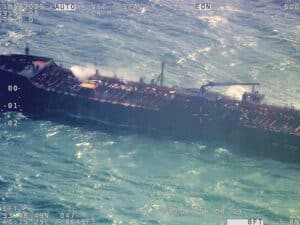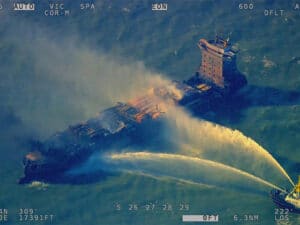
Maintenance deficiencies eyed in ferry grounding
Written by Nick Blenkey
Princess of Acadia grounded on opposite side of river to terminal
JANUARY 29, 2015 — The Transportation Safety Board of Canada (TSB) finds that maintenance deficiencies and lack of adequate emergency procedures led to the November 7, 2013 loss of electrical power and grounding of the passenger ferry Princess of Acadia in Digby, Nova Scotia. There were no injuries or pollution reported.
The Princess of Acadia was approaching the ferry terminal at Digby with 87 passengers and crew aboard when the incident occurred. In preparation for docking, as the bow thruster was started, the main generator blacked out causing a loss of electrical power and disabling the main propeller pitch control pumps. Once the pitch control pumps stopped, the propeller thrust defaulted toward full astern while the engines were still running, causing the vessel to slow down, stop and travel backwards towards the nearby shoreline until running aground.
The investigation found that a deteriorated generator component caused the failure of two main generators and the blackout of the main electrical switchboards, among other system failures.
The report says there were two main generators powering the main switchboard when the bow thruster was started; however, the No. 1 main generator was losing excitation due to a deteriorated brush, causing the generator to produce less power. The No. 2 generator was unable to produce the additional power required to start the bow thruster, and the breaker tripped from current overload, causing the interlock to activate and disable the bow thruster. Simultaneously, the deteriorated brush likely began arcing, which would have shorted out that set of brushes and caused the voltage on the No. 1 generator to drop until the under-voltage trip opened the breaker, resulting in a loss of power to the main and emergency switchboards.
 “On the Princess of Acadia,” says the report, “the company had switched to using softer exciter brushes in order to reduce costly maintenance of the rotor slip rings. Although the records from the planned maintenance program indicated that the brushes were only checked once every few months, the crew practice was to check the brushes on a more frequent basis. However, without records to document each time that the brushes were maintained, the intervals at which these tasks were performed would not be obtainable by the crew.
“On the Princess of Acadia,” says the report, “the company had switched to using softer exciter brushes in order to reduce costly maintenance of the rotor slip rings. Although the records from the planned maintenance program indicated that the brushes were only checked once every few months, the crew practice was to check the brushes on a more frequent basis. However, without records to document each time that the brushes were maintained, the intervals at which these tasks were performed would not be obtainable by the crew.
Comparison of a new brush (left) and the worn brush from the No. 1 generator (right)
“When a change of equipment, such as the switch to softer brushes, is made, it is important that the new equipment be inspected more frequently and that the results of these inspections be documented to build a maintenance history. This can assist in determining if any adjustments to the planned maintenance system are needed. In this case, the switch to softer brushes may have introduced new maintenance needs. However, maintenance and inspections of the brushes were not consistently documented, hampering the crew’s ability to accurately determine when the brushes should be replaced.
“If maintenance and inspections of vessel equipment are not documented with detailed and complete records, there is an increased risk that tracking of equipment reliability and related maintenance will be ineffective for determining overall maintenance needs.
“If maintenance schedules are not updated when critical equipment is modified or replaced, there is a risk that this equipment will not be serviced when necessary and, as a result, will not be fully operational when needed.”
The investigation also identified that neither the bridge nor the engine room had effective procedures in place to respond to the blackout of the main switchboard. Because of this, the master was not informed that engine room personnel were having difficulty restoring power, and the engine room was not aware of the urgency of the situation.
This impeded an effective response to the emergency.
The vessel had voluntarily implemented a safety management system (SMS), but it did not provide the master with guidance to proactively identify risks or investigate hazardous occurrences.
There were also deficiencies with passenger-related duties in written evacuation procedures and with Transport Canada’s oversight to ensure compliance with regulations regarding passenger safety emergency procedures. As such, there is a risk that these procedures will not achieve their intended purpose. Previous marine investigations (M12C0058 and M13L0067) have found deficiencies in the oversight of passenger safety regulations.
Following the occurrence, Bay Ferries Ltd., the vessel operator, instituted improved operating procedures for when the vessel prepares to arrive at Digby. It has also installed a simplified voyage data recorder, which records bridge audio and information navigation equipment and other available sensors. Llloyd’s Register, the vessel classification society, has increased the frequency for generator breaker testing.
Read the report HERE
BAY FERRIES ACTS ON TSB RECOMMENDATIONS
Bay Ferries said today that it has already acted on or will act on all of the recommendations provided by the Transportation Safety Board (TSB) in response to the grounding incident in November 2013.”Bay Ferries appreciates the work of the Transportation Safety Board and as always will remain dedicated to continuous improvement of operations to protect the safety of our passengers and our employees,” said CEO Mark MacDonald.
The TSB report recognized a number of improvements Bay Ferries has made since November 2013, including:
- Improved thruster testing on arrival at Digby;
- Better staff deployment in the engine room when the Princess of Acadia is arriving in Digby;
- A back-up battery power supply to the vessel’s navigational equipment; and
- Installing a simplified voyage data recorder, which records 12 hours of bridge audio and data from the radars, automatic identification system, and other available sensors.
Prior to the incident, inspection of the electrical components and the maintenance of equipment in question had been conducted at all times as required by the vessel’s classification society.
Bay Ferries also informed the TSB that regular communication took place between the bridge and the engine room.
“Since this incident took place more than a year ago, we looked at what we can do better as a company and proactively took action. This report will help our company continue to act to ensure safety is at the center of everything we do at Bay Ferries,” said Don Cormier, Vice President, Operations and Safety Management. “For more than 70 years, our companies have provided safe, reliable travel in the Maritimes, including close to 20 of those years in the Bay of Fundy. Every corner of this organization is committed to doing whatever it takes to uphold that tradition of safety for our passengers and our workers.”





Leave a Reply
You must be logged in to post a comment.